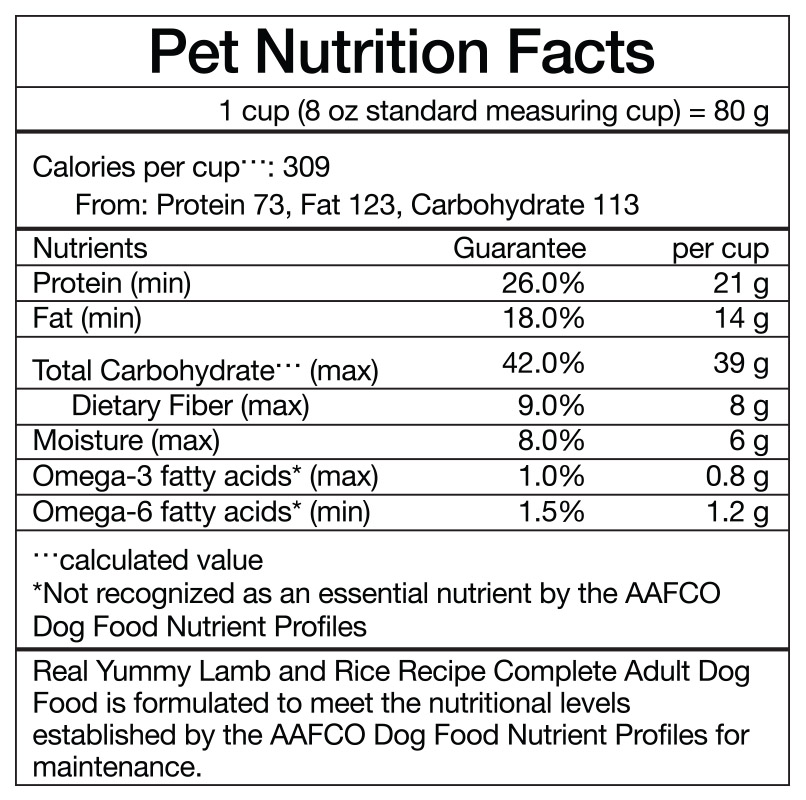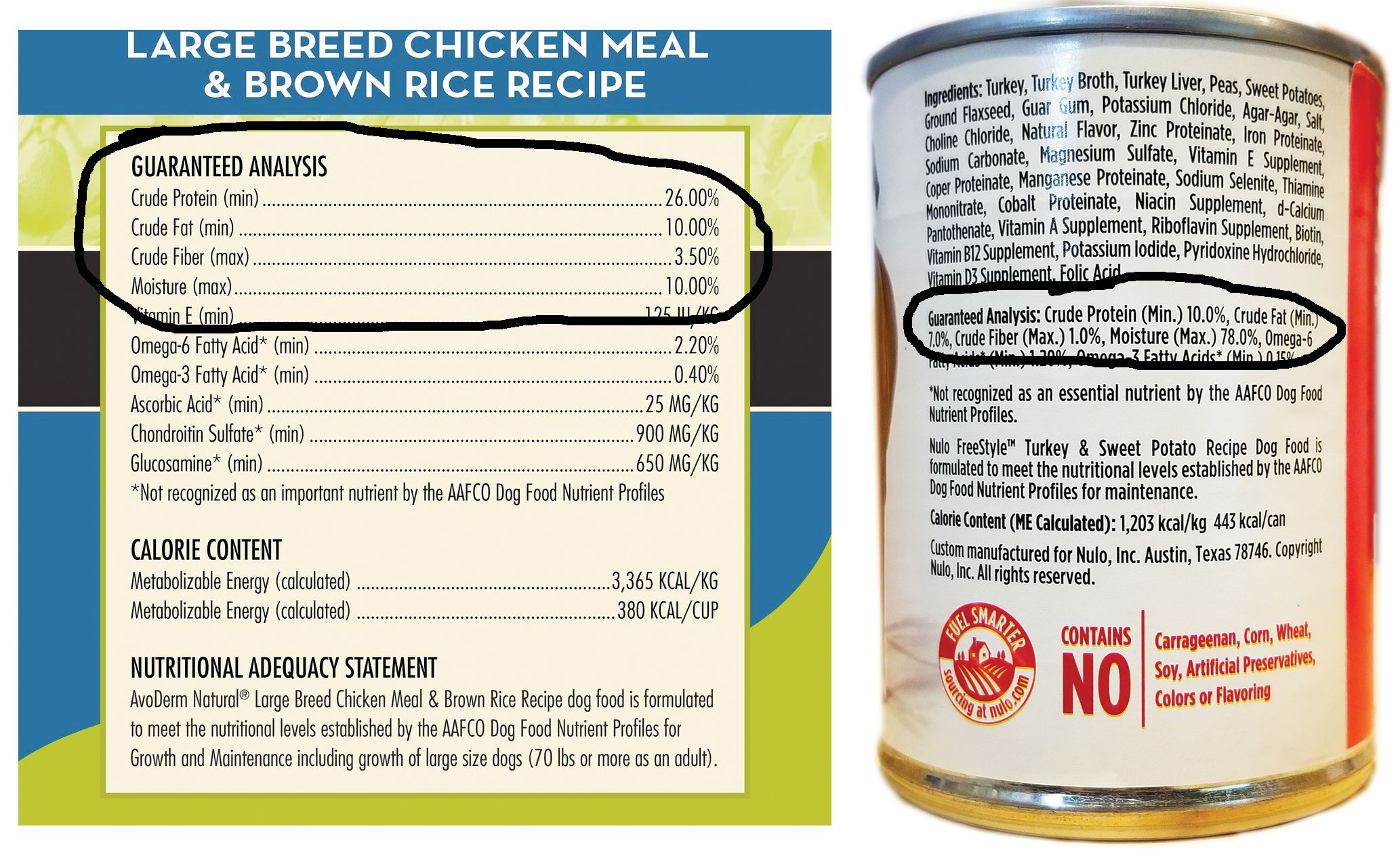A dog food nutrition label provides essential information about the ingredients and nutritional content of the product. Understanding this label helps pet owners make informed choices for their dogs' health.
Choosing the right dog food is crucial for your pet's well-being. The nutrition label serves as a guide, detailing important components such as protein, fat, fiber, and vitamins. It helps you compare different brands and formulations, ensuring you select a diet that meets your dog's specific needs.
Each ingredient plays a role in your dog's overall health, influencing energy levels, coat quality, and digestion. By analyzing these labels, you can find high-quality food that supports your dog's growth and activity. A well-informed choice leads to a happier, healthier companion. Prioritize your dog's nutrition for optimal longevity and vitality.

Credit: www.petfoodprocessing.net
Table of Contents
ToggleDeciphering Dog Food Labels
Understanding dog food labels is essential for pet owners. These labels provide vital information about the nutrition in your dog’s food. Knowing how to read these labels helps you choose the best diet for your furry friend.
Key Ingredients To Look For
Ingredients on dog food labels can be confusing. Here are the key ingredients you should look for:
- High-quality protein: Look for named meat sources like chicken, beef, or fish.
- Whole grains: Ingredients like brown rice or oats are beneficial.
- Fruits and vegetables: Carrots, blueberries, and sweet potatoes add vitamins.
- Healthy fats: Ingredients like chicken fat or fish oil support coat health.
Avoid foods with vague terms like “meat by-products.” These can contain low-quality ingredients.
Understanding Macronutrient Ratios
Macronutrients are the building blocks of a dog's diet. They include:
| Macronutrient | Role in Diet | Recommended Ratio |
|---|---|---|
| Protein | Builds and repairs tissues | 18-25% |
| Fats | Provides energy and supports skin health | 8-15% |
| Carbohydrates | Provides energy and aids digestion | 30-70% |
Check the guaranteed analysis on the label for these ratios. This information helps ensure your dog gets balanced nutrition.

Credit: www.whole-dog-journal.com
Nutritional Needs Of Different Dog Breeds
Understanding the nutritional needs of dogs is essential. Each breed has unique requirements. Factors like size, age, and activity level matter. Proper nutrition ensures health and longevity.
Small Vs. Large Breeds
Small and large dog breeds have different nutritional needs. Here’s a quick comparison:
| Feature | Small Breeds | Large Breeds |
|---|---|---|
| Caloric Needs | Higher metabolism | Lower metabolism |
| Protein Requirements | Higher protein content | Moderate protein content |
| Fat Requirements | Essential for energy | Balanced fats for health |
| Special Considerations | Dental health | Joint health |
Small breeds often need a higher calorie diet. They burn energy quickly. Large breeds require a balanced diet to support their size. This helps in maintaining joint health.
Breed-specific Formulations
Some dog foods are tailored to specific breeds. These formulas consider unique traits. Here are some common breed-specific needs:
- Energy Levels: Active breeds need more calories.
- Joint Support: Large breeds benefit from glucosamine.
- Skin and Coat: Breeds like Bulldogs need Omega fatty acids.
- Digestive Health: Small breeds often require easily digestible foods.
Choosing the right formula improves your dog's health. Always check the food label. Look for quality ingredients that meet your dog’s needs.
Life Stage Nutrition
Understanding your dog's nutritional needs is crucial. Each life stage demands specific nutrients. Feeding the right food helps support their health and energy levels. Let's explore the nutritional requirements for puppies, adults, and seniors.
Puppy Formulas
Puppies grow rapidly. They need a diet rich in essential nutrients. Puppy formulas contain higher protein and fat levels. This supports their growth and development.
- Protein: Essential for muscle development.
- Fat: Provides energy and supports healthy skin.
- Calcium: Vital for strong bones and teeth.
Look for food labeled as “puppy” or “growth.” These provide balanced nutrition for young dogs.
Adult Maintenance
Adult dogs require a balanced diet. This maintains their health and energy. Adult maintenance formulas have moderate protein and fat levels.
| Nutrient | Recommended Percentage |
|---|---|
| Protein | 18-25% |
| Fat | 8-15% |
| Fiber | 3-5% |
Choose a food labeled for “adult” dogs. This ensures proper nutrition for maintenance.
Senior Dog Requirements
Senior dogs have unique needs. Their metabolism slows down with age. They require lower calories but higher fiber. This helps maintain a healthy weight.
- Glucosamine: Supports joint health.
- Antioxidants: Boosts immune function.
- Protein: Helps maintain muscle mass.
Look for formulas labeled for “senior” dogs. These provide the right nutrients for aging pets.
Analyzing Protein Content
Protein is essential for your dog's health. It supports growth, energy, and muscle maintenance. Understanding protein content in dog food helps you choose the best diet.
Identifying Quality Protein Sources
Not all protein sources are created equal. Look for high-quality proteins in dog food. Quality proteins provide amino acids. These are the building blocks of life.
- Check the first ingredient. It should be a named meat.
- Look for meat meals, like chicken meal or fish meal.
- Avoid vague terms like “meat by-products.”
Plant Vs. Animal Proteins
Protein can come from plants or animals. Each type has its benefits and drawbacks.
| Protein Source | Benefits | Drawbacks |
|---|---|---|
| Animal Proteins | Complete amino acid profile. Highly digestible. | May contain allergens for some dogs. |
| Plant Proteins | Good for vegetarian diets. Often cheaper. | Incomplete amino acid profile. Harder to digest. |
Choose a mix of animal and plant proteins for balance. Quality and digestibility matter most.
The Truth About Fillers
Understanding dog food labels is crucial for pet owners. Fillers often appear in many dog foods. These ingredients can affect your dog's health. Knowing which fillers to avoid helps ensure your dog eats well.
Common Fillers To Avoid
- Corn: Often used as a cheap carbohydrate source.
- Wheat: Can trigger allergies in some dogs.
- Soy: Low-quality protein that may cause digestive issues.
- By-products: Unspecified animal parts, less nutritious.
- Cellulose: A filler that provides no nutritional value.
Their Impact On Dog Health
Fillers can harm your dog's health in various ways. They provide little nutrition. High filler content can lead to obesity. It can also cause digestive problems.
| Filler | Potential Health Issues |
|---|---|
| Corn | Allergies, obesity |
| Wheat | Skin issues, digestive problems |
| Soy | Gas, bloating |
| By-products | Poor overall health |
| Cellulose | Nutritional deficiencies |
Choosing high-quality dog food is essential. Look for foods with real meat and vegetables. Avoid products with high filler content. Your dog deserves better nutrition.
Additives And Preservatives
Understanding the role of additives and preservatives in dog food is essential. These ingredients can affect your dog's health and well-being. Knowing the difference between necessary and harmful additives helps you make informed choices.
Necessary Vs. Harmful Additives
Some additives are beneficial for your dog's diet. Others can be harmful. Here’s a breakdown:
| Additives | Purpose | Safety |
|---|---|---|
| Vitamins | Support overall health | Safe |
| Minerals | Strengthen bones and teeth | Safe |
| Flavor enhancers | Improve taste | Depends on source |
| Artificial colors | Make food appealing | Potentially harmful |
| Preservatives | Extend shelf life | Depends on type |
Choose dog foods with necessary additives. Avoid those with harmful ingredients. Always check the label.
Natural Preservatives
Natural preservatives are safer for your pet. They help keep food fresh without harmful effects. Here are some common natural preservatives:
- Vitamin E (Tocopherols)
- Vitamin C (Ascorbic Acid)
- Rosemary Extract
- Tocopherols (from plant oils)
These natural options offer safety and effectiveness. They protect food without side effects. Always opt for dog food with natural preservatives.
Grain-free And Special Diets
Choosing the right dog food is crucial for your pet's health. Many dog owners opt for grain-free and special diets. Understanding these options helps you make informed choices. Grain-free foods can be beneficial for certain dogs. Special diets address specific health needs. This section explores their benefits and uses.
Benefits Of Grain-free Foods
Grain-free dog foods have gained popularity for several reasons:
- Improved Digestion: Many dogs digest proteins better without grains.
- Allergy Relief: Grain-free foods may reduce allergic reactions.
- High Protein Content: These diets often contain more meat and fish.
- Weight Management: Grain-free options can help maintain a healthy weight.
These benefits make grain-free foods a great choice for many dogs. Always consult your vet before changing your dog’s diet.
When Special Diets Are Needed
Some dogs require special diets due to health issues. Common conditions that may need special diets include:
- Food allergies
- Obesity
- Diabetes
- Kidney disease
Special diets can provide tailored nutrition. They help manage specific health problems. Always consult with your veterinarian for the best options.
Monitoring your dog’s health is important. Regular check-ups ensure the diet meets their needs.

Credit: www.thewelldogplace.com
Understanding Food Allergies
Food allergies can affect your dog's health and behavior. Allergies occur when the immune system reacts to certain ingredients in dog food. Common symptoms include itching, digestive issues, and skin problems. Recognizing these symptoms early helps in providing the right care.
Common Allergens In Dog Food
Many ingredients can trigger allergies in dogs. Here are some of the most common allergens:
- Beef
- Dairy
- Chicken
- Wheat
- Eggs
- Fish
- Soy
Understanding these allergens is crucial for choosing the right food. Always check the nutrition label before purchasing dog food.
Choosing Hypoallergenic Options
Hypoallergenic dog food can help dogs with food allergies. These foods contain fewer common allergens. Look for options that include:
- Novel proteins like lamb or venison
- Limited ingredient diets with fewer components
- Grain-free formulas to reduce wheat sensitivity
Always consult with a veterinarian before switching foods. A vet can recommend the best hypoallergenic options for your dog.
The Role Of Fats And Oils
Fats and oils play a crucial role in dog food nutrition. They provide energy and support overall health. Understanding the types of fats is essential for your dog's well-being. Healthy fats can improve skin, coat, and brain function.
Balancing Omega Fatty Acids
Omega fatty acids are vital for your dog's health. These include Omega-3 and Omega-6 fatty acids. Each type serves a unique purpose:
| Type | Source | Benefits |
|---|---|---|
| Omega-3 | Fish oil, flaxseed | Reduces inflammation, supports heart health |
| Omega-6 | Chicken fat, corn oil | Supports skin health, promotes growth |
Balancing these fatty acids is important. An imbalance can lead to health issues. Aim for a ratio of 5:1 Omega-6 to Omega-3 in dog food.
The Skinny On Healthy Fats
Not all fats are bad. Healthy fats are essential for dogs. Here are some key points to remember:
- Energy Source: Fats provide concentrated energy.
- Skin and Coat: They improve skin health and coat shine.
- Brain Function: Healthy fats support cognitive functions.
- Absorption of Nutrients: Fats help absorb vitamins A, D, E, and K.
Include healthy fat sources in your dog's diet. Examples include fish oil, chicken fat, and flaxseed oil. Avoid trans fats and unhealthy oils. They can harm your dog's health.
Reading Beyond The Nutrition Label
Understanding your dog's food goes beyond just the nutrition label. Many factors affect the quality and safety of dog food. Knowing these factors can help you make better choices for your furry friend.
Manufacturer Reputation
The reputation of a dog food manufacturer matters greatly. A strong reputation often indicates quality and safety. Here are some key points to consider:
- Research the company's history.
- Look for customer reviews online.
- Check for recalls or safety issues.
- Evaluate their commitment to quality.
Top manufacturers invest in quality ingredients and follow strict safety standards. Trustworthy brands often provide transparency about their sourcing and production processes.
Organic And Non-gmo Certifications
Choosing organic or non-GMO dog food can enhance your pet's health. Certifications assure you of ingredient quality. Here’s what to look for:
- Organic Certification: Ensures no synthetic fertilizers or pesticides.
- Non-GMO Certification: Confirms ingredients are free from genetic modification.
These certifications often lead to:
- Higher nutrient levels.
- Better digestion.
- Fewer allergic reactions.
Consider brands that proudly display these certifications. They often prioritize the health of pets and the environment.
Frequently Asked Questions About Dog Food Nutrition Label Decoded
What Does A Dog Food Nutrition Label Include?
A dog food nutrition label includes essential information such as ingredients, guaranteed analysis, feeding guidelines, and nutritional adequacy statements. These details help pet owners understand the quality and quantity of nutrients in the food. It’s crucial for ensuring your dog receives a balanced diet.
How To Read Dog Food Nutrition Labels?
Reading dog food nutrition labels involves checking the ingredient list, guaranteed analysis, and feeding guidelines. Start by identifying high-quality ingredients at the top of the list. Then, review the guaranteed analysis for protein, fat, fiber, and moisture content. This helps you choose the best food for your dog.
Why Is Ingredient Quality Important In Dog Food?
Ingredient quality is vital in dog food because it directly affects your dog's health. High-quality ingredients provide better nutrition and digestibility. They also reduce the risk of allergies and health issues. Always prioritize foods with recognizable, whole ingredients for optimal canine wellness.
What Are Guaranteed Analysis Values In Dog Food?
Guaranteed analysis values in dog food indicate the minimum percentages of protein and fat, and maximum percentages of fiber and moisture. These values help pet owners assess the nutritional content of the food. Understanding these figures ensures you select a diet that meets your dog's specific needs.
Conclusion
Understanding dog food nutrition labels is essential for your pet's health. By reading these labels carefully, you can make informed choices. Always prioritize high-quality ingredients and appropriate nutrient levels. This ensures your dog receives a balanced diet. A well-nourished dog leads to a happier and healthier life.
Make every meal count!














